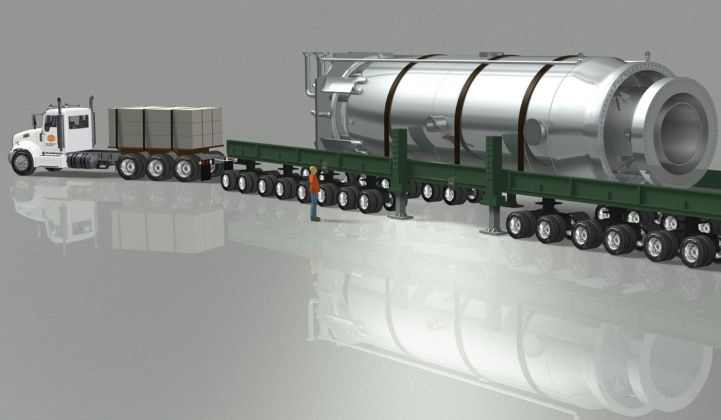As the wind gusts across the rural plains of Idaho rise and fall, a new type of nuclear plant could react in kind, generating more and less power in tandem with the wind farm.
That’s the vision laid out in a new paper from nuclear startup NuScale Power using computer models for a planned nuclear farm built near the Horse Butte Wind Project in Idaho.
The company, founded a decade ago, recently looked at how its modular nuclear reactors could follow clean energy, lowering and raising electricity output, if needed.
The surge of wind and solar in grids around the country is creating more variability in generation. As a result, power companies are starting to look at how traditional baseload energy sources like coal and nuclear can be more flexible, and lower their energy generation to avoid wasting power or overloading the grid.
In Germany, France, and Canada, some nuclear plants are already doing this, but it’s more out of necessity than design. Because NuScale’s reactors are much smaller than traditional nuclear reactors, the design can enable a power company to switch off individual modules, enabling load following (adjusting power output) in a more efficient way.
“We concluded that yes, we can load follow and we should be able to do it better and more responsibly than large nuclear plants,” said Daniel Ingersoll, NuScale Power’s director of research collaborations and lead author on the paper.
“Baseload plants are being forced into situations where they need to load-follow, and that’s not really operating those plants in their best form,” Ingersoll explained.
The findings are important because they provide a new way for nuclear energy to adapt and be more flexible as the grid mix changes. Some U.S. nuclear plants are getting shut down early, removing large sources of carbon-free baseload energy from the grid, and a handful of new nuclear plants are in danger of not getting built. It’s now cheaper to build natural gas and renewables in most states.
The U.S. has 90 nuclear reactors, which provide about a fifth of U.S. electricity needs. A recent study from MIT found that if all U.S. nuclear reactors at risk of operating uneconomically were replaced by new gas plants, U.S. emissions would jump by 4.9 percent.
Modular nuclear, like NuScale’s reactors, could offer a new role for the technology. “The whole issue of load-following comes down to economics,” said Ingersoll.
However, modular nuclear reactors aren’t yet available commercially. NuScale, the company closest to commercializing its tech, submitted designs to the Nuclear Regulatory Commission late last year. Regulators accepted the designs for review in March of this year.
If all goes well, NuScale’s first commercial plant could be operating in Idaho by 2026 for Utah Associated Municipal Power Systems and operated by Energy Northwest.
It’s supposed to take the NRC three years to review the design papers, which include 12,000 pages of technical information and work from 800 NuScale staff.
NuScale has been funded by the Department of Energy and by engineering giant Fluor Corporation. The company’s technology is based on light water reactor designs and uses a convection process, eliminating the need for pumps (which can break down) to circulate the cooling liquid.
Each NuScale reactor is 65 feet tall and 9 feet in diameter, and can produce 50 megawatts of power. The modules are meant to be grouped together, with up to 12 monitored by a single control room.
The NuScale reactors can load-follow by turning off individual reactors. They can also react quickly to changes in the grid by bypassing the steam turbine. However, all of these operations are theoretical until the NuScale reactors are up and running and operating in tandem with a wind or solar farm.
NuScale isn’t the only company working on modular reactors. Others include Terrestrial Energy, Babcock & Wilcox, Gen4Energy and UPower Technologies. But the nuclear industry, and its U.S. regulatory body, aren’t very friendly to entrepreneurship or change.
Nuclear entrepreneurs have advocated for a new federal approval process to get novel nuclear reactor designs to market much more quickly. Large funding needs and long lead times to commercialization have also proved difficult for nuclear entrepreneurs, particularly those supported by venture capital.
The federal government is presenting new challenges. President Trump’s budget doesn’t renew a grant that NuScale is using to fund its first plant in Idaho. The budget also proposes cutting the Department of Energy’s nuclear office by 31 percent, halves a program that extends the life of existing nuclear reactors, and slashes several advanced nuclear tech efforts.



